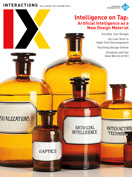Authors:
Uri Kartoun
A significant portion of my time at Massachusetts General Hospital (MGH) was spent analyzing a cohort of 65,099 individuals diagnosed with type 2 diabetes mellitus (T2DM). During these training years as a research fellow (2013 to 2016), I, along with my colleagues at MGH and Harvard, implemented a variety of predictive modeling methods as well as incorporated natural language processing techniques to better understand diseases and their complications. We focused on cardiovascular disease, liver disease, and insomnia. This T2DM cohort contained complete clinical details as well as demographics of patients who received care at MGH or Brigham and Women's…
You must be a member of SIGCHI, a subscriber to ACM's Digital Library, or an interactions subscriber to read the full text of this article.
GET ACCESS
Join ACM SIGCHIIn addition to all of the professional benefits of being a SIGCHI member, members get full access to interactions online content and receive the print version of the magazine bimonthly.
Subscribe to the ACM Digital Library
Get access to all interactions content online and the entire archive of ACM publications dating back to 1954. (Please check with your institution to see if it already has a subscription.)
Subscribe to interactions
Get full access to interactions online content and receive the print version of the magazine bimonthly.






